Let's analyze the production costs of physical Platinum.
Introduction: Production cost of platinum
“When you buy a commodity under its price of production, you are sure to make money sooner or later”. This saying is particularly true in period of high inflation and governments money printing. The main idea of the article is to study the cost of production of platinum.
In the first section, we will study the offer/demand for platinum and its price related to other commodities.
In the second section, we will show that the decrease in the AISC of platinum is related to the rand (ZAR) devaluation and also to the simulated production with palladium and rhodium.
In the third section, we will consider the main producers and deduce from their financial situation a real cost of production for platinum.
1. Platinum Prices is at Its Lowest Level for Decades.
As of 2021, platinum was at an all-time low of 1089US$ per ounce, while oil was at 84$US per barrel.

Oil is an important component of platinum production because a large amount of oil is used during mining operations. Therefore, it makes sense to see the price of platinum in terms of the price of oil. The graph above shows that the price of platinum relative to oil is the lowest it has been in decades.
If you compare the value of platinum to the value of gold, the result will be identical. The price of platinum in relation to the price of gold is one of the lowest in the last three decades as we can see in the graph below. Among the main factors is that gold is used mostly as an investment, while platinum is used for investment very rarely. Only up to 20% of platinum has ever been used for investment according to the World Platinum Investment Council. Nowadays the total investment in platinum is at 0%. The metal does not catch any interest from the investment community.
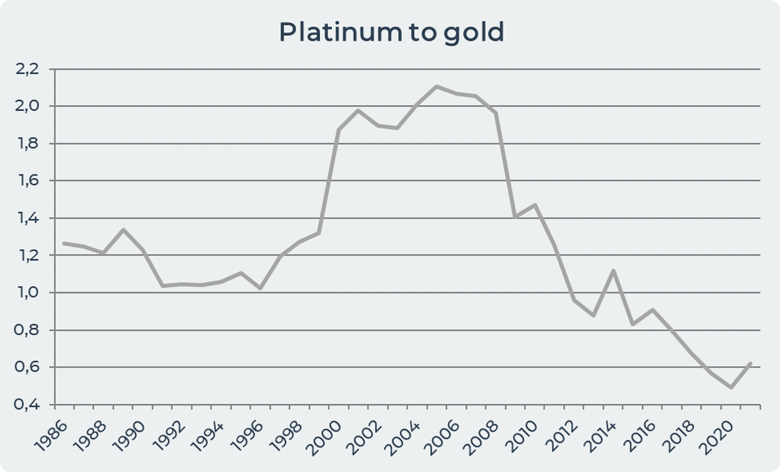
1.1 Demand and Supply of Platinum
The graph below shows that the platinum supply deficit occurred as early as 1999 and continued until 2017. The largest deficit was during the period of large miners' strikes in South Africa. Since then, the platinum deficit has begun to shrink due to decreased industrial demand for platinum and increased supply through increased production after miners returned to work following strikes.
Deficit is the difference between supply and demand. An increase in the deficit means that production has decreased or demand has increased.
In 2017 and 2018, the deficit was significantly reduced. The deficit is not related to the decrease in demand for cars, but to the collapse of investment demand. An identical situation occurs in 2019 and 2020, when the investment demand increased from 15 kOZ in 2018 to 1544 kOZ in 2020. However, in 2021, the demand for investment in platinum collapses again to -45 kOZ and we see a positive deficit.

In the period 2017-2021, the demand for platinum in the automotive industry also steadily decreased from 3,300 KOZ in 2017 to 2,638 KOZ in 2021. This is due to environmental regulations, the production level of diesel cars is decreasing and will continue to decrease, especially against the background of the EU's plans from 2035 to ban the sale and registration of cars with diesel engines.
The lack of interest in platinum as a means of investment is explained by the unattractive taxation policy of the governments of the countries. While gold is virtually VAT-free in most countries, platinum has a VAT of between 7% and 20% in most European countries. Therefore, platinum is not considered by many investors as a precious metal for investment. However, if there is a need for a large amount of gold, there will definitely not be enough for everyone. Then investors can turn to platinum as a good means of diversifying their own portfolio because platinum is one of the rarest metals and is 30 times rarer than gold. The sharp increase in demand for investment grade platinum will also lead to a supply and demand deficit.
2. Platinum AISC is Constantly Decreasing.
According to the World Gold Council the All-In Sustaining Cost (AISC) is an advanced metrics used by mining companies to report their cost of gold mining. AISC is an extension of currently existing “cash cost” metrics which includes sustainable production costs too.
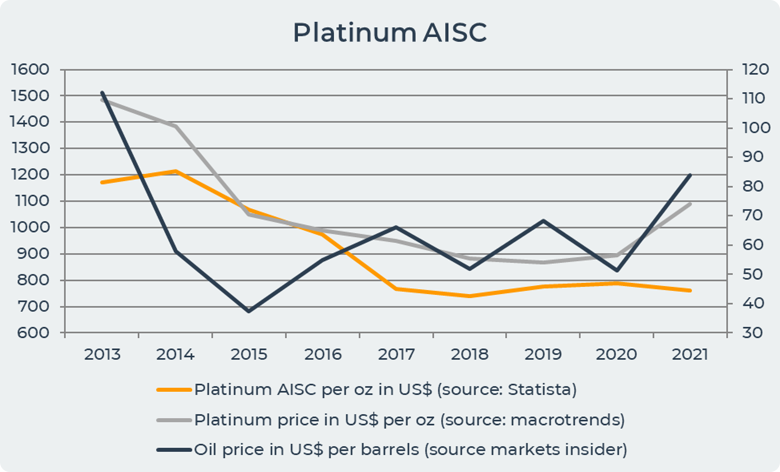
The average AISC was 760 US$ per platinum ounce in 2021. While the price of platinum was 1089 US$ per platinum ounce. The highest cost of platinum production was in 2014 when production costs were 1215 US$ per platinum ounce.
2.1 Reduction Drivers of Platinum AISC.
The graph below shows that the AISC of platinum has declined over the past 8 years. More than 70% of platinum is produced in South Africa, so it is logical that South Africa has a significant influence on the cost of platinum production. The correlation between AISC and the rand is 72%, which means that the denomination of the rand against the dollar leads to a decrease in the cost of platinum production. As a result, the ZAR-denominated AISC fell to a lower margin of 10.1% in 2021, according to Minxcon data.
Another aspect to consider is that each mine has a different shot split. A mine with more palladium and rhodium will have a higher basket price in the current price environment. Platinum mines have therefore been supported by higher palladium and rhodium prices in recent years, as well as a weaker rand, which has helped lower the AISC per ounce of platinum equivalent. The correlation between AISC and the share of the platinum price in the PGM 4E basket is 80%. PGM 4E basket is a price of platinum, palladium, rhodium and gold. The share of platinum in the PGM 4E basket decreased from 30% in 2013 to 6% in 2021 due to the sharp increase in rhodium and palladium.
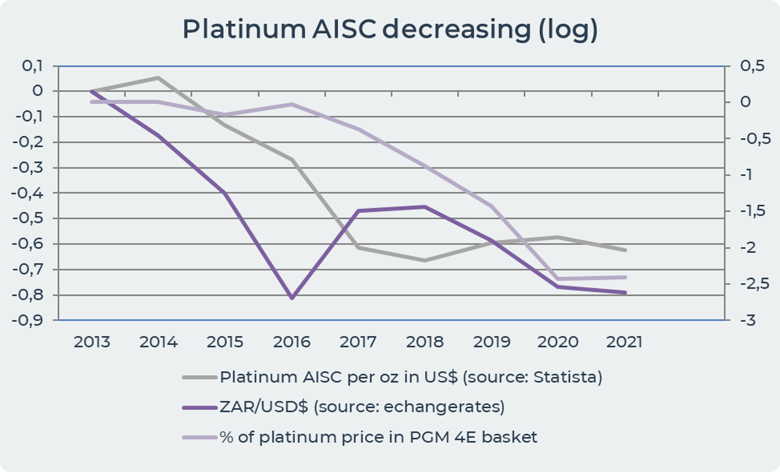
2.2 Marginal Platinum AISC is 1210 US$ per Platinum Ounce.
The real cost of production of platinum is the cost of production of the most expensive mines. Indeed, if the production amounts have to be maintained at current levels, the most expensive mines have to be profitable, and platinum price should be higher than their cost of production.
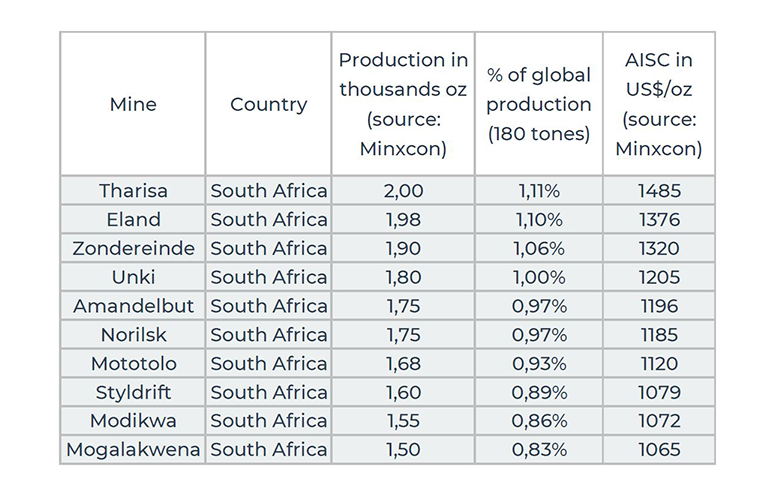
The AISC of the 10% most expensive mines in the world is 1210 US$/oz.
This cost of production is bigger than the price of platinum, so every buyer of the commodity should carefully monitor the cost of production. If price is lower than the cost of production then it is not sustainable for the commodity which may lead to a fall in the level of production or a rise in price. Some mines still have a higher cost of production than the price of platinum but continue to operate because the shutdown would result in even greater losses. It takes a lot of investment and time to restart the mines. Miners would have to pay fines, surrender their licenses and sell their equipment. Also, miners would have to fire their workers, which governments do not want to see. Therefore, all miners do their best not to stop their activities and hope for better times.
3. Implied Cost of Production from the Largest Producers Financial Statements
The average platinum AISC of the three largest platinum producers in the world is 1078 US$/oz after we recomputed the AISC. We take the earnings of the company and we divide by the amount of platinum produced. Obviously, we need companies which produce only platinum. This cost of platinum production is not significantly lower than the price of platinum in 2021. However, producers still had the opportunity to earn a margin on platinum sales.
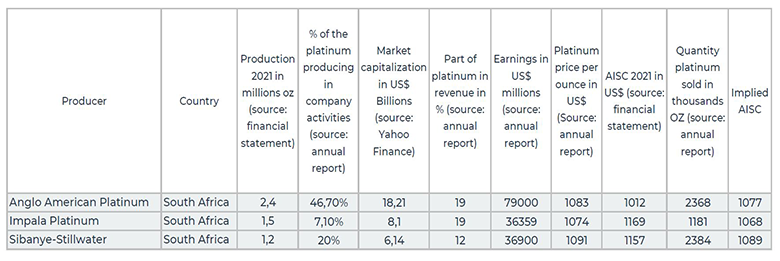
If we look at the financial situation of the three largest manufacturers, we can see a significant improvement in the return on capital. After the return on capital of the three largest producers was negative from 2012 to 2017, we see an improvement from 2018. Since 2018, companies have improved their performance and effectively used the capital of the shareholders. In 2021, Anglo American Platinum showed a result of 77% return on capital of the shareholders. While Sibanye-Stillwater has a 41% ROE and Impala Platinum 28%. The last 2 companies in 2021 worsened their ROE figures compared to 2020 and only Anglo American Platinum showed a significant increase in ROE. But we must remember that companies produce more than just platinum.

Conclusion
Platinum is a fairly rare metal in the world and is not considered by many investors as an investment method due to the unattractive taxation policies of governments. Although on the other hand we see that the price of platinum is the lowest in the last 30 years in relation to oil and gold. This situation is connected with the fact that gold is mostly considered as a precious metal for investments. After decades of supply and demand deficit, we have seen a positive trend in the last 5 years, but this is due to a sharp drop in demand for platinum as an investment and a drop in demand for platinum in the automotive industry due to green policies from governments.
The official platinum AISC was 760 US$ in 2021. However, the implied AISC from the financial statements of the major producers is 1076 US$/Oz. Additionally, the marginal AISC of the 10% more expensive mines stands at 1210 US$/Oz.
It is fair to say that many mines are still operating at a loss in order not to stop operations due to the threat of even greater financial losses. The decrease in the cost of platinum production is caused by the similar method of production of palladium and rhodium and the sharp increase in the prices of these metals, which led to a decrease in the share of platinum in the PGM 4E basket.
Major platinum producers have started to show positive dynamics in their financial indicators after 6 years of destroying shareholders' capital. In 2021, all three major manufacturers showed positive ROE results. And in the last 3 years, in general, we see positive indicators of return on capital.
Date= 7th October 2022, Gold price – 1721.40$, Silver price – 21.01$, Platinum price – 946.50$, Oil price – 88.90$
Source: Platinum: A Bargain


